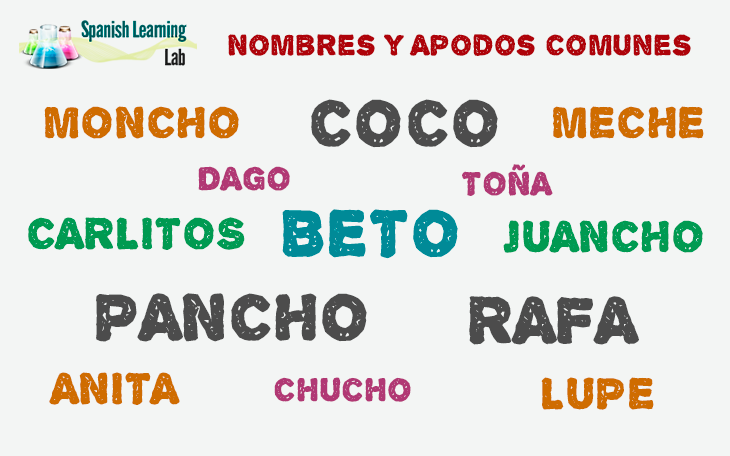¡Hola! Thanks for joining us in this basic lesson. Today, we will learn some very common nicknames in Spanish and use this new vocabulary in two listening activities. You will listen to people introducing themselves in Spanish and also talking about their nicknames and where they come from. Let’s start…
Vocabulary Introduction: A list of common nicknames in Spanish
First, nicknames are really common in Latin America. They are normally used as a way to refer to friends and family members in a more affectionate or casual way. Just like English nicknames, nicknames in Spanish are oftentimes very similar to the original name and sometimes they differ a lot. Take a look at the picture below and guess the real names of some of these people based on their nicknames.

Spanish Nicknames based on Names
As you can see in the picture above, there are many nicknames in Spanish, and many are actually born from names, sometimes due to a similar pronunciation with the original name or as a way to shorten them. Here is a list of names with their corresponding “apodos” or “sobrenombres”:
|
Beto – Alberto, Adalberto, Humberto, Roberto, Rigoberto, etc.
|
|
Cata – Catalina
|
|
Coco – Socorro
|
|
Concho(a) – Concepción
|
|
Chayo – Rosario
|
|
Chema – José María
|
|
Chente – Vicente
|
|
Dagoberto – Dago
|
|
Goyo – Gregorio
|
|
Juancho – Juan José
|
|
Lupe – Guadalupe
|
|
Magda – Magdalena
|
|
Meche – Mercedes
|
|
Moncho – Ramón
|
|
Mundo – Edmundo, Raimundo, etc.
|
|
Nacho – Ignacio
|
|
Poncho – Alfonso
|
|
Rafa – Rafael
|
|
Toña – Antonia
|
|
Tere – Teresa
|
There is one more category of nicknames in Spanish that is extremely common. It consists of words ending in the suffix “-ITO/A”, for example: “Manuel” and “Manuelito”, “Jaime” and “Jaimito” or “Rosa” and “Rosita”. You can do this with most names in the language, except for long names, as it may sound awkward. When the name ends in the vowel “E”, we must substitute the last “E” for “I”.
Spanish nicknames based on people’s appearance
Some nicknames in Spanish are born out of a physical feature. For instance, the word “Pelón” (bald) is used as a kind way to call newborns, but sometimes it becomes a permanent nickname for guys. The same word “Pelón” can also be used for someone that has gone bald due to age or so on. Those nicknames related to physical appearance are fascinating, but they could sound disrespectful at times, so be careful when using them. Here are a few of them and the physical traits they are related to:
| Physical Trait | Nickname | Physical Trait | Nickname |
| A bald person | Pelón | Someone thin or skinny | Flaco/a |
| A short person | Chaparro/a | An attractive woman | Mami/Mamacita |
| A short person | Chiquito/a | An attractive man | Papi/Papacito |
| Attractive | Guapo/a | A muscle guy | Fortachón |
| Attractive (for girls) | Bonita | A person with big eyes | Ojón / Ojona |
| Blondie | Rubia | Someone you love | Amor |
| White or fair skin person | Chele | Someone you love | Tesoro |
| Brown skin person | Moreno/a | Someone you love | Cariño |
| A chubby kid | Gordito/a | A little girl | Princesa |
| A person with green eyes | Gato/gata | A little boy | Príncipe |
Listening Activity No. 1: Friends and nicknames in Spanish
Key expressions in the conversation:
- “Me he perdido”, means “I haven’t been around for a while!”
- “Le mando saludos”, means “I send him greetings!”
Listening Activity No. 2: Spanish nicknames at work
Key expressions in the conversation:
- “Entrar en confianza” means “Gain confidence!”
- “Llamarlos por su nombre” means “Call them by their names”
- “De cariño le decimos” means “We kindly call her/him…”
This is all for this lesson. We hope you found it useful. We will cover more nicknames in Spanish in future lessons. Leave us a comment if you have any suggestion and tell us how well you did in the listening quizzes. ¡Hasta pronto!
Related PDF Worksheets:
- Names and Nicknames in Spanish
- Physical Appearance & Nicknames in Spanish –Word Search
- Talking about Yourself in Spanish (Conversation cards)
- Getting to Know People in Spanish
